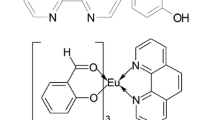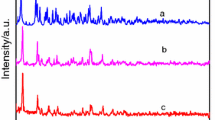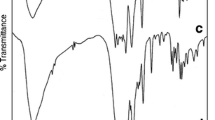Abstract
Novel Schiff base ligands derived from N′-benzylidene-benzohydrazide (substituted by –H, −CH3, −OCH3, −Cl) and 2-chloro-N-phenylacetamide were synthesized. The solid complexes of rare earth (Eu, Tb) nitrate with these Schiff base ligands were synthesized and characterized by elemental analysis, EDTA titrimetric analysis, thermal analysis, infrared spectra and UV–Vis spectra analysis. The fluorescence properties of rare earth (Eu, Tb) complexes in solid were studied. Under the excitation of ultraviolet light, these complexes exhibited characteristic emission of europium and terbium ions. The results showed that the ligand favored energy transfer to the emitting energy of Eu and Tb ions. Effects of different ligands on the fluorescence intensity of rare earth (Eu, Tb) complexes had been discussed. The electrochemical properties of rare earth (Eu, Tb) complexes were also investigated.










Similar content being viewed by others
Abbreviations
- UV–Vis:
-
Ultraviolet visible
- EDTA:
-
Ethylenediaminetetraacetic acid
- HOMO:
-
Highest occupied molecular orbital
- LUMO:
-
Lowest unoccupied molecular orbital
References
Gouveia-Neto AS, da Costa EB, Bueno LA, Ribeiro SJL (2004) Upconversion luminescence in transparent glass ceramics containing β-PbF2 nanocrystals doped with erbium. J Alloys Compd 375:224–228
Gandara F, Gutierrez-Puebla E, Iglesias M, Snejko N, Angeles Monge M (2010) Isolated hexanuclear hydroxo lanthanide secondary building units in a rare-earth polymeric framework based on p-sulfonatocalix[4]arene. Cryst. Growth Des 10:128–134
Tanabe S (2006) Optical properties and local structure of rare-earth-doped amplifier for broad band telecommunication. J. Alloys Compd 408–412:675–679
Fabbri P, Mohammad Poor S, Ferrari L, Rovati L, Borsacchi S, Geppi M, Lima PP, Carlos LD (2014) Highly stable plastic optical fibre amplifiers containing [Eu(btfa)3(MeOH)(bpeta)]: a luminophore able to drive the synthesis of polyisocyanates. Polym 55:488–494
Mascharak PK (2002) Structural and functional models of nitrile hydratase. Coord Chem Rev 225:201–214
Gutierrez F, Tedeschi C, Maron L, Daudey JP, Poteau R, Azema J, Tisnès P, Picard C (2004) Quantum chemistry-based interpretations on the lowest triplet state of luminescent lanthaides complexes. Part 1. Relation between the triplet state energy of hydroxamate complexes and their luminescence properties. J Chem Soc Dalton Trans 9:1334–1347
Latva M, Takalob H, Mukkala VM, Matachescuc C, Rodriguez-Ubisd JC, Kankarea J (1997) Correlation between the lowest triplet state energy level of the ligand and lanthanide (III) luminescence quantum yield. J Lumin 75:149–169
Kanmani Raja K, Indra Gandhi N, Lekha L, Easwaramoorthy D, Rajagopal G (2014) Synthesis, spectral, electrochemical and catalytic properties of Ru(III) Schiff base complexes containing N, O donors. J Mol Struct 1060:49–57
Shi Q, Xu LJ, Ji JX, Li YM, Wang RH, Zhou ZY, Cao R, Hong MC, Chan ASC (2004) Syntheses and structures of two anion-templated dinuclear cadmium complexes with diamino-binaphthyl Schiff bases as ligands. Inorg Chem Commun 7:1254–1257
Okawa H, Furutachi H, Fenton DE (1998) Heterodinuclear metal complexes of phenol-based compartmental macrocycles. Coord Chem Rev 174:51–75
Sawodny WJ, Riederer M (1977) Addition compounds with polymeric chromium(II)-Schiff base complexes. Angew Chem Int Ed Eng 16:859–860
Taha ZA, Ajlouni AM, Al-Hassan KA, Hijazi AK, Faig AB (2011) Syntheses, characterization, biological activity and fluorescence properties of bis-(salicyladehyde)-1,3-propylenediimine Schiff base ligand and its lanthanide complexes. Spectrochim Acta A 81317–323
Yoon II, Narita M, Shimizu T, Asakawa M (2004) Threading-followed-by-shrinking protocol for the synthesis of a [2]rotaxane incorporating a Pd(II) − salophen moiety. J Am Chem Soc 126:16740–16741
Liu YH, He W, Yang ZH, Chen YW, Wang XW, Guo DC (2015) Synthesis, characterization and properties of novel amide derivatives based open-chain crown ether and their Tb (III) complexes. J Lumin 160:35–42
Eldehna WM, Ibrahim HS, Abdel-Aziz HA, Farrag NN, Youssef MM (2015) Design, synthesis and in vitro antitumor activity of novel N-substituted-4-phenyl/benzylphthalazin-1-ones. Eur J Med Chem 89:549–560
Sato S, Wada M (1970) Relations between intramolecular energy transfer efficiencies and triplet state energies in rare earth β-diketone chelates. Bull Chem Soc Jpn 43:1955–1962
Bard AJ, Memming R, Miller B (1991) Terminology in semiconductor electrochemistry and photoelectrochemical energy conversion. Pure Appl Chem 63:569–596
Kirby AF, Richardson FS (1983) Detailed analysis of the optical absorption and emission spectra of europium(3+) in the trigonal (C3) Eu(DBM)3.H2O system. J Phys Chem 87:2544–2556
Meng DF, Liu F, Lian XM, Yang ZH, Guo DC (2014) Synthesis and properties of salicyladehyde salicyhydrazon derivatives and their europium complexes. J Fluor esc 24:1661–1669
Geary WJ (1971) The use of conductivity measurements in organic solvents for the characterisation of coordination compounds. Coord Chem Rev 7:81–122
Qiang S (1993) Chemistry of rare earths. Henan Technology &Science Press, Zhengzhou, pp. 304–314(in Chinese)
Trasatti S (1986) The absolute electrode potential: an explanatory note. Pure Appl Chem 58:955–966
Acknowledgments
We are grateful to the financial support of the National Natural Science Foundation of China (No.J1103312; No.J1210040; No.21341010), the Innovative Research Team in University (No.IRT1238) and chemical excellent engineer training program of Hunan university. We also thank Dr. William Hickey, the U.S. professor of HRM, for the English editing on this paper.
Author information
Authors and Affiliations
Corresponding author
Rights and permissions
About this article
Cite this article
Liu, Y., Kong, W., Yang, Z. et al. Synthesis and Fluorescence Properties of Eu3+, Tb3+ Complexes with Schiff Base Derivatives. J Fluoresc 26, 567–576 (2016). https://doi.org/10.1007/s10895-015-1741-8
Received:
Accepted:
Published:
Issue Date:
DOI: https://doi.org/10.1007/s10895-015-1741-8




